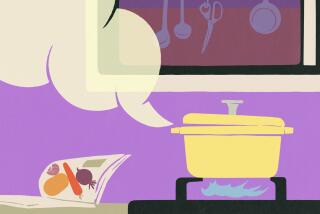Inspired eye for the fungi
In this crazy foodie time, when venison is raised like cattle and foie gras has become commonplace, wild mushrooms are one of the last great edible rarities.
Though a few of them are starting to pop up in high-end groceries and at select farmers markets, for the most part, to cook with them, you either have to hunt them yourself or be willing to pay a lot of money to someone who has.
So how useful can a cookbook devoted to them be? That was the big question when I headed into the kitchen with Antonio Carluccio’s new “The Complete Mushroom Book” (Rizzoli, $39.95).
Carluccio is one of those British cookbook authors who have never quite found their audience in the American market. It’s not for lack of trying. He’s published more than 40 books (four on mushrooms alone), though you’ll have to look hard to find them in this country.
Neither is it for lack of quality. His “Passion for Mushrooms” (published in 1989) is one of the best cookbooks on the subject. At least until this latest one.
Published by Rizzoli, better known for lavishly illustrated books on art and architecture than for cookbooks, “The Complete Mushroom Book” is beautifully photographed. Dominated by autumnal shades of brown and green, it is bound to be irresistible to those with a mushroom habit. Call it fungi-porn.
The book opens with a 70-page field guide to mushrooms, both wild and domestic, which includes photographs of most varieties as well as information about where they grow and how to identify them.
Though it is about as complete as any written for the popular market, I do find it a little scary to think about people heading to the woods relying on it to make decisions. The book makes a splendid inspiration for a foray, but do find an experienced mushroom hunter to accompany you when you actually go out.
After the introduction comes the cooking: 150-odd recipes, most of them calling for specific mushrooms. But when a recipe for a Spanish-style mushroom tortilla calls for “green-cracked russulas,” is that really the only mushroom that will work? Is pappardelle with fresh porcini pointless without the porcini?
The answer, thankfully, is no, at least much of the time.
That pappardelle with porcini was delicious even when made without fresh porcini (and without pappardelle either, for that matter). I used what I could find at the grocery: some portabellos and some pretty ratty-looking sliced button mushrooms.
These were sautéed with soaked dried porcini in what initially looked like way too much olive oil and butter, and seasoned only with the usual onion, garlic, white wine, parsley and Parmigiano. Then I combined the sauce with perciatelli, a round chewy dried pasta that can substitute for the prescribed flat noodles.
Wow: The essence of wild mushroom pasta without having to tromp through the woods. What made it work so well? It’s hard to say — there was certainly nothing unique in either the ingredients or the techniques. But this was one recipe where the alchemy came together perfectly. Doubtless it would be better made with freshly cut porcini, but equally doubtless most of us would only be able to do that once in a blue moon.
Most of the other recipes tested also worked well, even without the exotic mushrooms. The aforementioned tortilla had a rich perfume that seemed like wild mushrooms, despite being made with portabellos rather than the green-cracked russulas.
Though Carluccio lives in England and includes mushrooms (and recipes) with an Asian inflection, he is at heart an Italian cook. His best dishes are all about getting the purest flavor with just a few simple techniques.
The tasty enoki bundles, for example, are little more than slender pale mushrooms (these are cultivated and widely available) lightly dressed in lemon juice and wrapped in thin slices of prosciutto. Even though the mushrooms are Japanese, the end effect is distinctly Italian.
Another of my favorite recipes is the one for pickled mushrooms. Anyone who has traveled in Italy has probably been served a little plate of them as part of an antipasti assortment, just a little something sharp to whet the appetite.
I made Carluccio’s pickles with some curious, vaguely porcini-like domestic mushrooms I’d found at a Japanese market (in this case, the actual recipe was nonspecific, calling only for “fresh mushrooms”). When I’d cooked with them before, I’d found them to be extremely fibrous, almost to the point of crunchiness, even after being grilled or cooked in soup. Kind of weird in those contexts, but maybe perfect for a pickle, I thought.
Delicious pickles
Not only did the book help me identify the mushroom (cultivated “king oysters,” Pleurotus eryngii, found in Japanese markets as eryngi shimeji), but it was indeed a great choice for the recipe. Put together in minutes, these pickles will keep for months in the refrigerator. Unexpected guests? Toss a few of these subtly piquant mushrooms with a little olive oil and maybe some minced parsley and you’ve got a really elegant first course to serve alongside sliced ham or dried sausages.Still, rather than having to experiment on your own, it would have been nice for Carluccio to include some information on substitutions for those who hunt their mushrooms in the grocery aisles.
Domestic substitutions didn’t always work so wonderfully. As a kind of acid test, I tried substituting ordinary button mushrooms in Carluccio’s risotto with Amanita caesarea — a rare, extremely flavorful wild mushroom. Would the porcini pappardelle magic repeat? Well, it wasn’t awful (how bad can a risotto be when made with two tablespoons of butter and a tablespoon of grated Parmigiano per serving?), but it certainly wasn’t special.
Similarly lackluster were the braised porcini when made with buttons. That was true even after adjusting the recipe to allow for mistranslation of measurements from British to American. (Someone certainly should have caught that you needed only a quarter-cup of chicken stock, not four cups.)
Maybe that’s the lesson: The wild mushroom recipes that work best when made with domestics tend to be the ones where there are other dominant flavors — the dried porcini in the pasta, the brine in the pickles.
However Carluccio does it, getting supermarket mushrooms to taste like something at all is a kind of minor miracle. It may not be on the same scale as turning water into wine, but for this mushroom lover it comes darned close.
*
Pappardelle with porcini
Total time: 50 minutes
Servings: 4
Note: Adapted from “The Complete Mushroom Book” by Antonio Carluccio.
6 tablespoons olive oil
3 tablespoons butter
1 onion, minced
1 garlic clove, minced
3/4ounce dried porcini, soaked in
warm water for 20 minutes
1/4cup dry white wine
3/4pound fresh, firm porcini, or other meaty mushrooms such as portabello, coarsely chopped
2 tablespoons minced parsley
Salt and pepper to taste
3/4pound pappardelle or other broad, flat noodle
3/4cup freshly grated Parmesan
1. Heat the olive oil and butter in a skillet over medium heat. Add the onion and cook until soft, about 5 minutes. Add the garlic and cook another 2 to 3 minutes.
2. Drain the soaked porcini, reserving the soaking liquid, and chop them coarsely. Strain the soaking liquid. Add the soaked porcini and the wine to the skillet and cook until the raw smell of the alcohol evaporates, about 2 minutes.
3. Add the fresh porcini and the strained soaking liquid and cook until the mixture is nearly dry, about 10 minutes. Add the parsley and season to taste with salt and pepper. Keep warm until the pasta is ready.
4. Cook the pappardelle in plenty of rapidly boiling, well-salted water until it is tender to the bite, about 3 minutes for fresh pasta, 10 minutes for dried. Drain the pasta well and combine it in a mixing bowl with about three-fourths of the sauce. Add most of the grated Parmesan and toss well to mix. The sauce should just barely coat the pasta.
5. Divide the sauced pasta among 4 warmed serving plates. Spoon a little of the reserved sauce in the center of each, and top with a little more grated Parmesan.
Each serving: 702 calories; 21 grams protein; 74 grams carbohydrates; 5 grams fiber; 35 grams fat; 11 grams saturated fat; 35 mg. cholesterol; 296 mg. sodium.
*
Mushroom tortilla
Total time: 45 minutes
Servings: 4
Note: Adapted from “The Complete Mushroom Book” by Antonio Carluccio.The tortilla may be eaten cold, but I prefer it hot with good fresh bread.
12 eggs, beaten
1 tablespoon chopped parsley
1/4cup grated manchego cheese
1 teaspoon salt
1/4 teaspoon pepper
1/4cup extra-virgin olive oil
1 large onion, minced
3/4pound fresh green-cracked russula mushrooms, or other meaty mushrooms such as portabellos, diced (about 3 1/2 cups diced)
1. In a large mixing bowl, beat together the eggs, parsley, cheese, salt and pepper.
2. Heat the oil in a 10-inch nonstick skillet over medium heat and cook the onion until softened, about 5 minutes. Add the mushrooms and cook 7 to 8 minutes more.
3. Reduce the heat to low, add the egg mixture and stir it occasionally with a wooden spatula until the eggs begin to solidify. After about 5 minutes, when the egg mixture is not liquid on top any more, cover the pan. Check occasionally and if bubbles form, prick them with a fork. Cook to build a brown crust on the tortilla bottom, about 15 minutes more, occasionally sliding a spatula around the bottom to prevent sticking.
4. Loosen the tortilla by running a spatula around the edge before removing it. Take a large plate and, taking care not to burn yourself, cover the pan with it and turn it upside down. Slide the tortilla back into the pan on its soft side and cook for a few more minutes until it is solid.
Each serving: 417 calories; 23 grams protein; 9 grams carbohydrates; 2 grams fiber; 32 grams fat; 8 grams saturated fat; 644 mg. cholesterol; 237 mg. sodium.
*
Pickled mushrooms in brine
Total time: 1 hour plus chilling time
Servings: 24 (makes 1 quart)
Note: Adapted from “The Complete Mushroom Book” by Antonio Carluccio.
4 1/2pounds firm, meaty mushrooms, such as button, portabello or king oyster (eryngi shimeji)
Salt
5 cups white wine vinegar
2 1/2cups water
1 small sprig rosemary
Black peppercorns
6 bay leaves
1 onion, quartered
2 whole cloves garlic, peeled
1. Clean the mushrooms and slice in quarters or thirds, according to their size.
2. Combine 1 tablespoon salt, vinegar, water, rosemary, a few peppercorns, bay leaves, onion and garlic in a saucepan and bring to a boil. Cook 15 minutes.
3. Meanwhile, cook the mushrooms in plenty of rapidly boiling salted water until they are firm but tender, about 3 to 5 minutes for large mushrooms, less for smaller ones. You may want to cook the mushrooms in several batches if they are of various sizes. When the mushrooms are done, transfer them to the boiling brine and cook another 5 minutes.
4. Remove the mushrooms to a sealable container. Boil the brine another 10 minutes. Strain the brine and cool completely. Cover the mushrooms with the brine, cover them tightly and refrigerate until ready to use.
5. To serve, drain the mushrooms completely and dress with a few drops of olive oil.
Each serving: 25 calories; 2 grams protein; 4 grams carbohydrates; 1 grams fiber; 0 fat; 0 saturated fat; 0 cholesterol; 294 mg. sodium.
More to Read
Sign up for our L.A. Times Plants newsletter
At the start of each month, get a roundup of upcoming plant-related activities and events in Southern California, along with links to tips and articles you may have missed.
You may occasionally receive promotional content from the Los Angeles Times.







